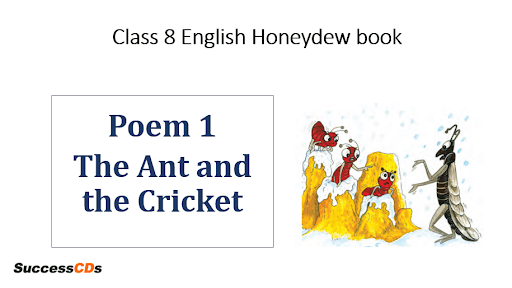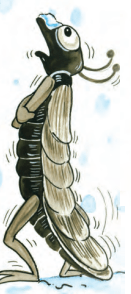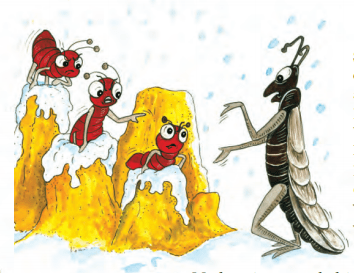The Ant and the Cricket Class 8 Poem 1 Summary, Difficult words from English Honeydew Book
The Ant and the Cricket Class 8 Poem 1 summary and detailed explanation of the poem along with meanings of difficult words and literary devices used in the poem. Given here is the complete explanation of the Poems, along with summary. All the exercises and Question and Answers given at the back of the lesson
Class 8 English (Honeydew Book) Poem 1 The Ant and the Cricket
-adapted from Aesop’s Fables

- The Ant and the Cricket Introduction
- The Ant and the Cricket Summary
- The Ant and the Cricket Summary in Hindi
- The Ant and the Cricket Poem Explanation
- The Ant and the Cricket Question and Answers
- NCERT Class 8 English MCQs with Answers
- Class 8 English Honeydew Word meaning of Prose | Chapterwise
- Class 8 English Honeydew Book All Poems Word meanings
- Class 8 English It So Happened Book Chapter wise Word meanings
The Ant and the Cricket Introduction
The poem “The Ant and the Cricket” has been adopted from Aesop’s Fables. A fable is a fiction and short story, depicting animals, generally conveying a moral. The poem however, through a teeny-tiny ant, teaches us a significant lesson for life. The lesson not only pertains to the “four-legged” cricket, but is also applicable in situations concerning “two-legged crickets”(humans).
The Ant and the Cricket Summary
The poem “The Ant and the Cricket” begins with the story of a silly, thoughtless and young cricket who was used to singing day and night throughout the months of summer and spring. As soon as the winters approached, he began complaining about his empty cupboard. On the snow-covered ground, he could not find even a single crumb to eat. He had no shelter and could see no flowers or leaves on trees. He gets worried as to what will happen to him without the food and shelter. Soaked in rain, struck by hunger and in the situation of scarcity of food, he decided to seek the help of the tiny ant. He only wanted to borrow and intended upon repaying it. A mouthful of grain and shelter from the rain was all he asked for. Without this, he must die of starvation and misery. The ant however, had a policy. They neither borrow nor lend. The ant asked the cricket what he did all summer and spring when there was ample food and water. He told the ant that he sang day and night all the time, without planning about the future. The ant further advises him to similarly dance the winter away. The ant then throws him out of the door. The poet mentions how people think it to be only a fable but he thinks otherwise and he even justifies his opinion. There are a lot of crickets like him, ‘four-legged’ and ‘two-legged’ who irresponsibly waste all their time without planning for unsuitable circumstances.
The Ant and the Cricket Class 8 Summary in Hindi
कविता “द एंट एंड द क्रिकेट” एक मूर्ख, विचारहीन और युवा क्रिकेट की कहानी से शुरू होती है, जो गर्मियों और वसंत के महीनों में दिन-रात गाने के आदी थे। सर्दियां आते ही वह अपनी खाली अलमारी की शिकायत करने लगा। बर्फ से ढकी जमीन पर उसे खाने के लिए एक टुकड़ा भी नहीं मिला। उसके पास कोई आश्रय नहीं था और वह पेड़ों पर फूल या पत्ते नहीं देख सकता था। वह चिंतित हो जाता है कि भोजन और आश्रय के बिना उसका क्या होगा। बारिश में भीगने, भूख से त्रस्त और भोजन की कमी की स्थिति में, उसने नन्ही चींटी की मदद लेने का फैसला किया। वह केवल उधार लेना चाहता था और उसे चुकाने का इरादा रखता था। एक कौर अनाज और बारिश से बचने के लिए उसने बस इतना ही मांगा था। इसके बिना, उसे भूख और दुख से मरना होगा। हालाँकि, चींटी की एक नीति थी। वे न उधार लेते हैं और न उधार देते हैं। चींटी ने क्रिकेट से पूछा कि जब पर्याप्त भोजन और पानी था तो उसने सभी गर्मियों और वसंत ऋतु में क्या किया। उसने चींटी से कहा कि वह भविष्य की योजना बनाए बिना, दिन-रात गाता है। चींटी आगे उसे सलाह देती है कि वह इसी तरह सर्दियों को दूर नृत्य करे। चींटी फिर उसे दरवाजे से बाहर फेंक देती है। कवि उल्लेख करता है कि कैसे लोग इसे केवल एक कल्पित कहानी मानते हैं लेकिन वह अन्यथा सोचता है और वह अपनी राय को सही ठहराता भी है। उनके जैसे बहुत सारे क्रिकेटर हैं, ‘फोर-लेग्ड’ और ‘टू-लेग्ड’ जो अनुपयुक्त परिस्थितियों की योजना बनाए बिना अपना सारा समय गैर-जिम्मेदाराना तरीके से बर्बाद करते हैं।

The Ant and the Cricket Class 8 Poem Explanation
Poem
A silly young cricket, accustomed to sing
Through the warm, sunny months of gay summer and spring,
Began to complain when he found that, at home,
His cupboard was empty, and winter was come.
Not a crumb to be found
On the snow-covered ground;
Not a flower could he see,
Not a leaf on a tree.
“Oh! what will become,” says the cricket, “of me?”
Word Meaning:
Accustomed to sing– used to singing; in the habit of singing
Gay– light-hearted and carefree
Crumb– a small fragment of bread, cake or biscuit
Explanation of the Poem – The poem introduces us to a young and thoughtless cricket who is used to singing in the warm and sunny months of the light-hearted summer and spring season. The months of spring and summer have been called “gay” because there is greenery everywhere and everything is blooming. Food and other resources are also sufficient during these seasons.
As the winter season came, he realised that his cupboard at home was empty. He began complaining as soon as he realised that. He could not even find a single crumb or morsel to eat on the snow-covered ground. There were no flowers or leaves in sight as it was the winter season. He became worried as to what will happen to him without food and shelter.
Poem
At last by starvation and famine made bold,
All dripping with wet, and all trembling with cold,
Away he set off to a miserly ant,
To see if, to keep him alive, he would grant
Him shelter from rain,
And a mouthful of grain.
He wished only to borrow;
He’d repay it tomorrow;
If not, he must die of starvation and sorrow
Word Meaning:
Famine– extreme scarcity of food
Trembling– shaking or quivering, typically as a result of anxiety, excitement or weakness
Miserly– small
Explanation of the Poem – When there was extreme scarcity of food and he was struck by hunger, all drenched in water and shaking with cold, he decided to seek help from tiny ants. He wished for them to help him stay alive by providing him a roof over his head to protect himself from rain and something to eat. His intention was to only borrow and he planned on repaying it when he was in the right shape. He was in a condition that if he did not get any help, he would lose his life to starvation and misery.

Poem
Says the ant to the cricket, “I’m your servant and friend,
But we ants never borrow; we ants never lend.
But tell me, dear cricket, did you lay nothing by
When the weather was warm?” Quoth the cricket, “Not I!
My heart was so light
That I sang day and night,
For all nature looked gay.”
“You sang, Sir, you say?
Go then,” says the ant, “and dance the winter away.”
Word Meaning:
Lay nothing by – save nothing
Quoth– (old english) said
Explanation of the Poem – On hearing the cricket, the ant replied that he can consider them his friend or even his servant, but it is a policy of the ants to neither borrow nor lend. The ant further asked the cricket if he stored anything during the summer season, when there was abundance of food and resources. The cricket replied by telling the ant that he did not save anything because he was so happy and light-hearted when it was warm that all he did was sing day and night. He did not think or plan for the future when the weather was “gay”.
The ant tells him to go away and pass the winters by dancing just like he passed the summers by singing.
Poem
Thus ending, he hastily lifted the wicket,
And out of the door turned the poor little cricket.
Folks call this a fable. I’ll warrant it true:
Some crickets have four legs, and some have two.
Word Meaning:
Hastily– with excessive speed or urgency; hurriedly
Lifted the wicket- put an end to the conversation (here)
Fable– a short story, typically with animals as characters, conveying a moral
Warrant– justify
Explanation of the Poem – After telling the cricket to dance the winter away, the ant quickly put an end to the conversation and kicked the miserable cricket out of the door. The poet mentions that a lot of people think it is an untrue story of an ant and the cricket but the poet is of another opinion. He mentions there are crickets, with four legs and there are some with two lega as well, which means there are the insects and even human beings that live like the cricket. They do not prepare or plan for the future and regret when the time is gone.
The Ant and the Cricket NCERT Solutions – Question and Answers
Working with the poem
1.The cricket says, “Oh! what will become of me?” When does he say it, and why?
A. As the winter season came, the cricket realised that his cupboard at home was empty. He began complaining as soon as he realised that. He could not even find a single piece of something to eat on the snow-covered ground. There were no flowers or leaves in sight as it was the winter season. He became worried as to what will happen to him without food and shelter and that is when he says, “Oh! what will become of me?” .
2. (i) Find in the poem the lines that mean the same as “Neither a borrower nor a lender be” (Shakespeare).
A. In the poem the lines that mean the same as “Neither a borrower nor a lender be” (Shakespeare) are “But we ants never borrow; we ants never lend.”
(ii) What is your opinion of the ant’s principles?
A. The ant’s principle to neither borrow nor lend teaches us a very important lesson of utilising our time and resources wisely when circumstances are in our favour. It is important to enjoy in the moment but it is also very important to plan for the future or situations where circumstances might not be in our favour. The ants don’t depend on anyone for their living. I think the ant’s principles are right and appropriate.
3. The ant tells the cricket to “dance the winter away”. Do you think the word ‘dance’ is appropriate here? If so, why?
A. Upon hearing that the cricket sang day and night all summer, the ant tells the cricket to “dance the winter away”. The word “dance” here refers to merry-making and enjoyment. By this word, the ant meant not doing any responsible work or planning for the future. Thus, the word ‘dance’ is appropriate here.
4. (i) Which lines in the poem express the poet’s comment? Read them aloud.
A. The lines in the poem that express the poet’s comments are “Folks call this a fable. I’ll warrant it true:
Some crickets have four legs, and some have two.”
(ii) Write the comment in your own words.
The poet mentions that a lot of people think it is an untrue story of an ant and the cricket but the poet is of another opinion. He mentions there are cricket with four legs whereas there are with two as well, which means there are other insects and even human beings that live like the cricket. They waste all their time. They do not prepare or plan for the future and regret when the time is gone.
The Ant and the Cricket- Rhyme Scheme
The rhyme scheme for the entire poem is aabbccdविदाई संभाषण Question Answers | NCERT Solutions Class 11 Chapter 4dd
The Ant and the Cricket- Literary devices
1. Personification- the attribution of a personal nature or human characteristics to something non-human, or the representation of an abstract quality in human form
In this poem, the ant and the cricket are personified.
2. Metaphor- a figure of speech in which a word or phrase is applied to an object or action to which it is not literally applicable
In this line, “Some crickets have four legs, and some have two.”, the poet has compared lazy humans with the cricket.
3. Alliteration- the occurrence of the same letter or sound at the beginning of adjacent or closely connected words
“When the weather was warm?” (when, weather, warm), You sang, Sir, you say? ( sang, sir, say)
Also See :
Honeydew Book Poems
- Geography Lesson, Class 8 CBSE English Poem Summary, Explanation
- Macavity: The Mystery Cat, Class 8 CBSE English Poem Summary, Explanation
- The Last Bargain, Class 8 CBSE English Poem Summary, Explanation
- The School Boy, Class 8 CBSE English Poem Summary, Explanation
- When I set out for Lyonnesse, Class 8 CBSE English Poem Summary, Explanation
- On the Grasshopper and Cricket, Class 8 CBSE English Poem Summary, Explanation
Honeydew Book Lessons
- Class 8 English Chapter 1 The Best Christmas Present in the World notes
- The Tsunami Class 8 English Chapter 2 Explanation, Question Answers
- Glimpses of the Past Class 8 English Chapter 3 Explanation and Summary
- Bepin Choudhury’s Lapse of Memory Class 8 English Chapter 4
- The Summit Within, Class 8 CBSE English Lesson Summary, Explanation
- This is Jody’s Fawn, Class 8 CBSE English Lesson Summary, Explanation
- A Visit to Cambridge, Class 8 CBSE English Lesson Summary, Explanation
- A Short Monsoon Diary Class 8 Summary, Explanation, difficult words
- The Great Stone Face-I, Class 8 CBSE English Lesson Summary, Explanation
- The Great Stone Face-II, Class 8 CBSE English Lesson Summary, Explanation
It so Happened Book Lessons
- How the Camel got his hump, Class 8 CBSE English Lesson Summary, Explanation
- Children at work, Class 8 CBSE English Lesson Summary, Explanation<
- The Selfish Giant, Class 8 CBSE English Lesson Summary, Explanation
- The Treasure Within, Class 8 CBSE English Lesson Summary, Explanation
- Princess September, Class 8 CBSE English Lesson Summary, Explanation
- The Fight, Class 8 CBSE English Lesson Summary, Explanation
- The Open Window, Class 8 CBSE English Lesson Summary, Explanation
- Jalebis, Class 8 CBSE English Lesson Summary, Explanation
- The Comet-I, Class 8 CBSE English Lesson Summary, Explanation
- The Comet-II, Class 8 CBSE English Lesson Summary, Explanation
- Ancient Education System of India Class 8 Summary, Explanation